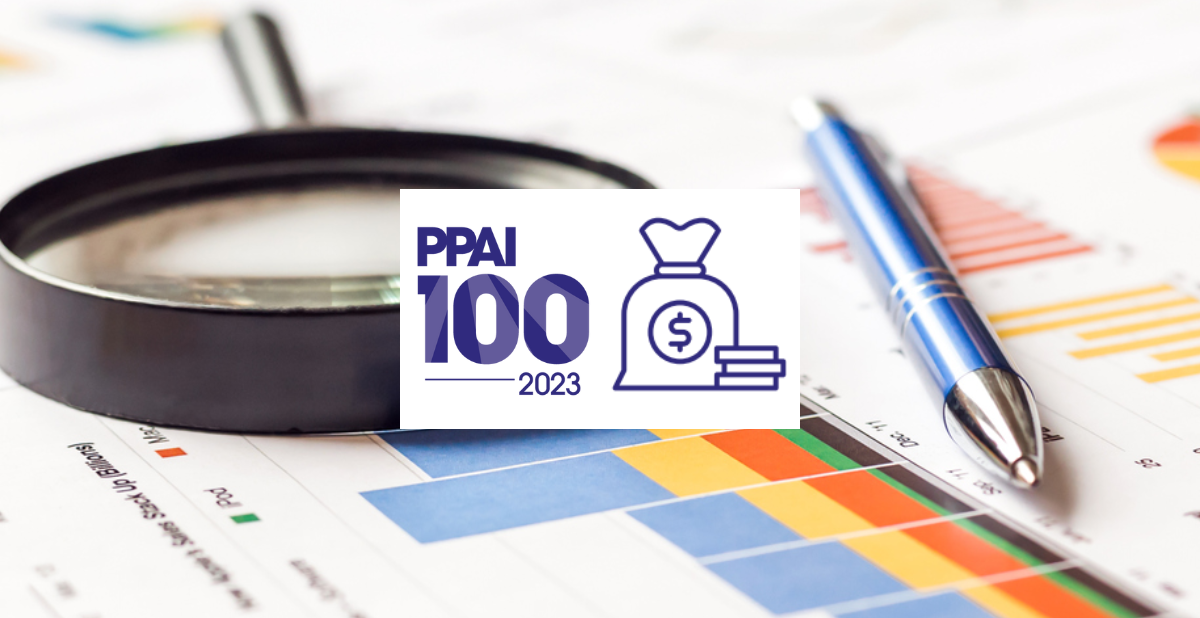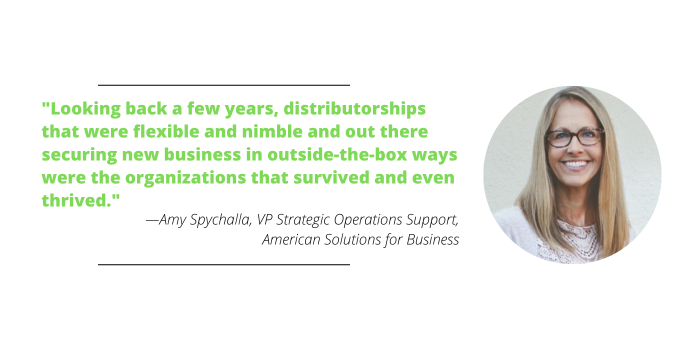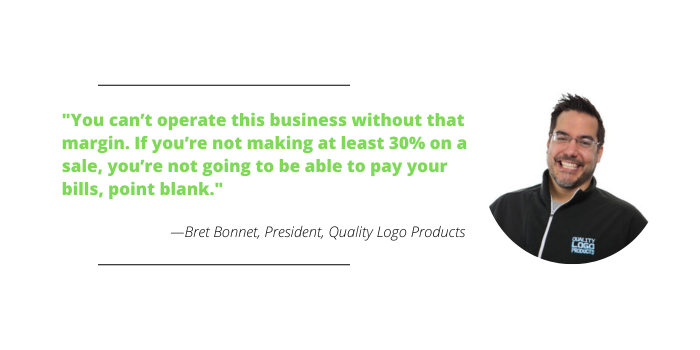PPAI 100 Distributor Benchmarking: Business Practices Of The Industry Leaders

PPAI 100 is more than just a ranking of distributors and suppliers.
It’s a roadmap for what the industry can look like and a resource for member companies to know where they stand compared to their highly performing peers, not just in the ranking but with key statistical figures gathered by PPAI Research.
As part of the PPAI 100 rollout, the Association has gathered some distributor benchmarking data provided by companies that appeared in the inaugural ranking, available as reference for any interested industry members.
Last week, we looked at some averages and median numbers for the suppliers that made the list.
Today we share the key performance indicators of the PPAI 100 distributors. Unlike suppliers, which saw a fairly large gap between its largest companies – three suppliers north of $2 billion in revenue – and the mid-size companies, the averages among the distributors are slightly less skewed by outliers at the top. Still, the data below includes both averages and median statistics.
Below is a breakdown of each benchmarking statistic, with insight and reaction from decision makers among the ranking distributors.
DIDN’T GET THIS IN YOUR EMAIL? Subscribe to PPAI Newslink.
2022 Revenue
PPAI 100 Average: $194.8 million
PPAI 100 Median : $119.5 million
2022 was a record-breaking year for promo, topping $25 billion in sales for the first time ever, and there’s no denying that these numbers prove that the industry is in a healthy place with plenty of distributors willing to invest in opportunities that net positive results.
Bret Bonnet, co-founder and president of Quality Logo Products, which came in at No. 30 on the PPAI 100 list, suggests that with so many strategic investments by distributors, an interesting benchmarking statistic for the future would be revenue or profit generated per employee.
“That [statistic would also be] a sign of the technology or the efficiencies in that business,” Bonnet says. “I don’t care if I sell $60 million of revenue to make $1 million of profit. Everyone is obsessed with revenue, but it doesn’t always mean much. You can sell $100 million and still lose $100 million.”
Revenue Change Since 2019
PPAI 100 Average : +28%
PPAI 100 Median : +17%
As everyone knows, 2019 was followed by a period of such uncertainty and difficult compromises that it is hard to believe that the promotional product industry would have grown so significantly only a few years later, rather than still licking its wounds from 2020.
These numbers are taken from the distributors that PPAI 100 has deemed to be setting examples for the industry in ways beyond just revenue. A few of the figures below explain why each of them might have had successful growth in 2022.

New Client Revenue
PPAI 100 Average : 20%
PPAI 100 Median : 18%
According to Amy Spychalla, VP of strategic operations support at American Solutions for Business, which came in at No. 9 on PPAI 100, new client revenue has a lot to do with the recent growth among these distributors.
“Business development is more important than ever,” Spychalla says. “Looking back a few years, distributorships that were flexible and nimble and out there securing new business in outside-the-box ways were the organizations that survived and even thrived.”
Gross Profit Margin
PPAI 100 Average: 34%
PPAI 100 Median: 35%
Gross profit margin hovered around this percentage for both distributors and suppliers, making it a key industry figure.
“As for why 35% became the magic number for the industry over the past few decades, this would relate to the costs of running an efficient supplier or distributorship in our industry,” says Vera Muzzillo, CEO of Proforma, which landed the No. 6 spot on PPAI 100. “As our costs are fairly stable and controllable in this industry and include a mix of high and low-cost resources, 35% appears to be a reasonable margin.”
Both Muzzillo and Bonnet agree that the specifics of those margins are important. Thirty-five percent is better than 34%, and anything much lower than that can become a point of concern.
“You can’t operate this business without that margin,” Bonnet says. “It just tells me you cannot run and be successful and pay your bills at the end of the year if you don’t have the margin right around there in this business, considering the costs of labor, advertising, overhead, capital, all that stuff. If you’re not making at least 30% on a sale, you’re not going to be able to pay your bills, point blank.”

Revenue From Top Three Clients
PPAI 100 Average: 16%
PPAI 100 Median: 12%
This number can vary from distributor to distributor.
Muzzillo says that it came in a little bit lower than she expected, knowing how many distributors rely heavily on companies they have formed good relationships with, but also points to the new client revenue statistic above. It only makes sense that these two figures would affect each other.
Spychalla, on the other hand, points out that getting that number even lower would eliminate risk in the industry.
“Our largest client represents only 1% of our overall business,” Spychalla says. “That being said, there’s always the fear of having too many eggs in one basket. Diversification across the board is key, including product categories, vendors, vertical markets and serving clients of all shapes and sizes. Targeting just the large ones can put distributorships at a disadvantage should they lose a large account.”
Revenue From Top 10% Of Sales Reps
PPAI 100 Averages: 28%
PPAI 100 Median: 23%
Similarly, this number can fluctuate for different distributors and might skew lower for larger companies, but Spychalla warns against getting complacent relying on big business to come in from the same sales reps, especially on an otherwise large team.
“It’s important to take care of top earners, but equally as important to invest in that next tier of sales associates with helpful education, networking and mentoring opportunities,” Spychalla says.
Days To Payment
PPAI 100 Average: 43
PPAI 100 Median: 45
ASB is one of the distributors in PPAI 100 that came in slightly below the average and median days before payment.
“A few keys here include forming strong partnerships with customers built on trust and doing your homework before taking on a new customer to ensure they are stable and reliable,” Spychalla says. “Offering and implementing prompt paid discount incentives is helpful, too, and can be a win-win for everyone. Our sales associates are paid commissions on paid orders and not booked orders which incentivizes them to collect from their customers quickly.
“We also operate our business with controlled growth in mind; ASB makes calculated moves to ensure we remain fiscally responsible where it matters most. This allows us to pay our partners quickly and accurately.”
Full-time Finance Staff
PPAI 100 Average: 15
PPAI 100 Median: 7
This is a figure obviously impacted by financial resources, but it can be a helpful point of reference to know where other companies stand in this regard. The large gap between average and median suggests that companies with much smaller finance staffs are still managing to operate at a level worthy of making PPAI 100.

Customer Service Reps
PPAI 100 Average: 74
PPAI 100 Median: 25
Another example of a large contrast between median and average due to a high volume of customer service reps by the industry’s largest distributors.
The ability to work with customers quickly to eliminate any issues or concerns certainly contributes to these companies’ success, but savvy investments in technology and online orders can often eliminate frictions in the order process, which could give some companies the ability to operate at a high level with less customer service reps.
Q1 2023 vs. Q1 2022
PPAI 100 Average: 7%
PPAI 100 Median: 6%
It’s hard not to be optimistic about following up a record-breaking year in promo with Q1 growth. However, it is important to remember that Q1 was not the strongest quarter for 2022, and the year produced higher revenues as supply chain issues carried over from the previous year.
“Business appears to be normalized for the most part as inventory levels and business have returned to normal, and pandemic-related conditions have resolved,” says Muzzillo.
Interestingly, these Q1 figures are more moderate than what was gathered by a larger survey effort this spring, when PPAI asked a panel of distributors of all sizes how their Q1 of 2022 compared to Q1 the year prior. In that survey, respondents reported an average increase of 11.3%.

